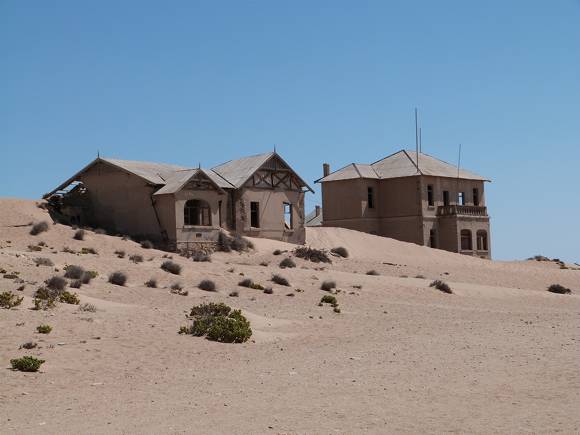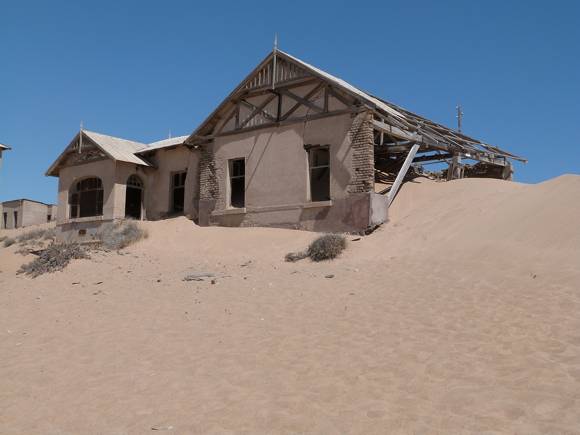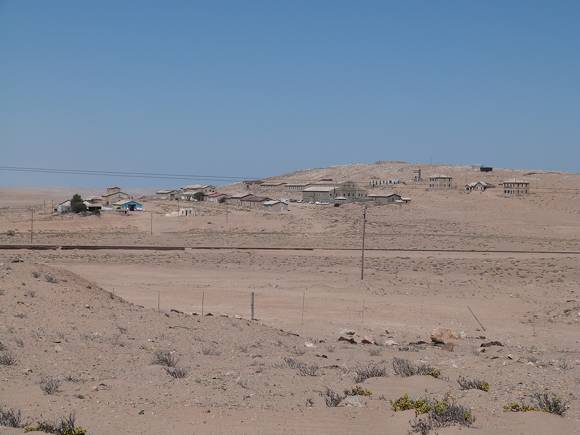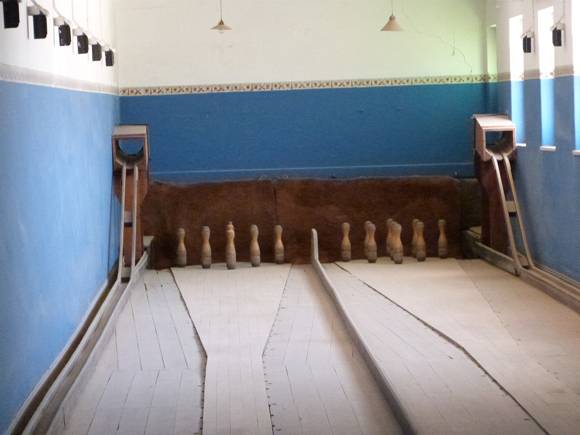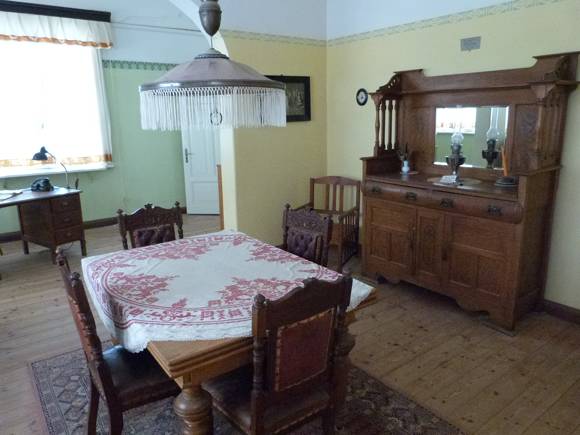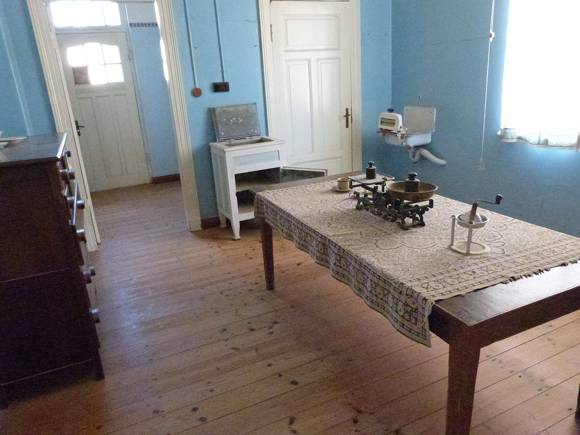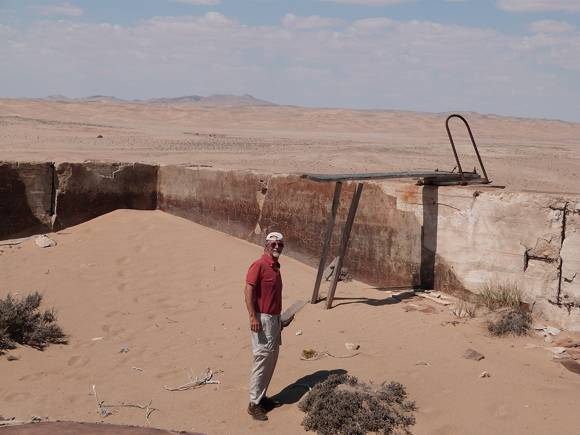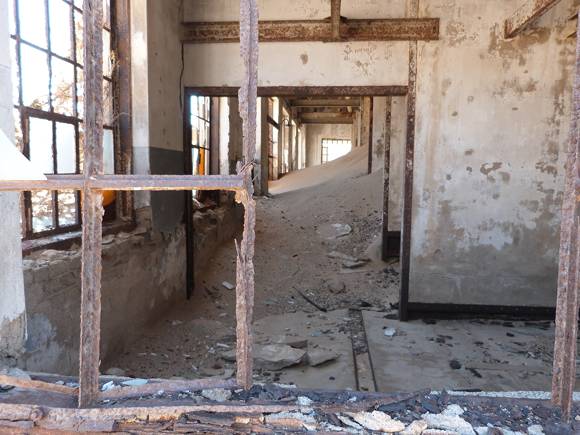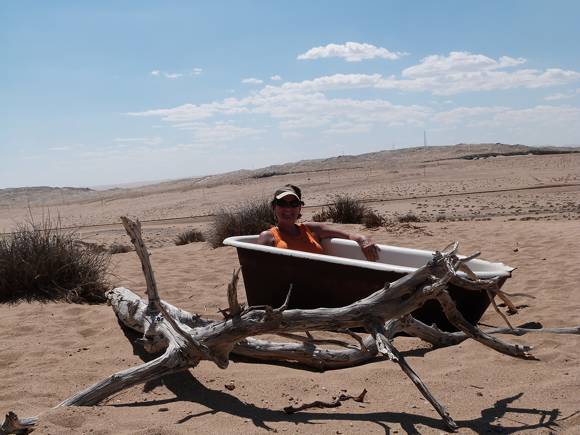Diamonds are Forever

You can see where they are actually rebuilding the tracks today. In 1908, the train line from Luderitz to Kolmanskop took eleven months to build. Currently, they have been working on this same stretch of the tracks for six years!This once “Beyond Your Wildest Dreams” boom town went bust after just 22 years but, oh what a Riches to Ruins story it has to tell…Diamonds are Forever but…Not Always!!!
There’s nothing that warms a girl’s heart quite like the words, “You want to go visit a diamond mine?”
Considering that I’ve reluctantly agreed to wander through countless marine hardware stores and just about every moth-ridden Maritime Museum on the face of this earth over the past five years, it was about time for a change of pace. So, when Peter suggested a trip to the town of Kolmanskop, Namibia which is administered by NamDeb (as in De Beers) I said, “NOW, YOU’RE TALKING!!!”
Trouble is…Kolmanskop is a ghost town. (I KNEW there was a catch!)
But, hope springs eternal and who’s to say there wouldn’t be one teensy-weentsy little diamond sparkling in the sand that those miners happened to miss?
So, off we drove to Kolmanskop, an abandoned colonial German town founded in 1908. Kolmanskop lies just 9 kilometers from the port of Luderitz, where Peregrina was anchored on the southwest coast of Namibia.
It’s the quiet that strikes you first. Words cannot describe the affect that the wind and sand dunes have on the landscape. It’s as if the sand is slowly swallowing the town from the outside-in. Beautiful homes, once incredible mansions that rivaled any equivalent in Berlin, Frankfurt, Cape Town, London or New York at the turn of the century are now being devoured by an endless wave of sand that pours off the sea and rolls into town, seeping through doors and windows that have no defense against the march of time.
Prior to the discovery of diamonds, Kolmanskop was just a desolate stop along the railroad tracks to Luderitz in the middle of the Namib Desert.
------------------------------------------------------------------------------------------------
But, back in 1908, everything was changing very rapidly. The Kolmanskop “diamond rush” really DID happen overnight as the guide tells us and it changed the course of history for what was then South West Africa, at that time a colony of Germany, and what we know, today, as the independent nation of Namibia.
A railway worker, Zacharias Lewala, from the Owambo tribe, found a strangely sparkling stone as he was shoveling sand away from the tracks. He showed it to his German foreman, August Stauch, who scratched the diamond on his watchface and immediately determined it was real. The next day, Stauch staked claims on the surrounding area and began prospecting for diamonds. Turns out, it wasn’t too difficult as deposits were so rich that the diamonds were literally laying on the surface of the sand.
Where did the diamonds come from you ask? Well, it was quite a journey! These gem-quality diamonds, unlike most of the commercial grade diamonds that are mined in Africa, were relatively small but of fine quality and brought down by the waters of the Orange River which lies to the south on the border between Africa and Namibia. The stones tumbled their way to the mouth of the river where they were carried north by the current and then they were, literally, swept by the wind onto the desert sands of the Namib!
It didn’t take long for the word to get out and the news spread like wildfire, sparking a huge, frantic diamond rush encouraging fortune hunters to converge on Kolmanskop in droves. In no time, a well-to-do German colonial town, providing shelter from the harsh environment of the Namib Desert and a standard of living (at least, for the German families, the mining officials and soldiers stationed there) that far exceeded anything seen before in South West Africa/Namibia or most other parts of the world for that matter. Large, elegant houses were built complete with electricity and an impressive array of support amenities including: a hospital, ballroom, power station, school, 4-lane skittle (bowling) alley, theatre and sports hall, casino, ice factory and the first x-ray station in the southern hemisphere. (More on this x-ray later!
Fresh meat could be purchased at the butcher's, located next door to the ice house with cold air blown in to keep everything from spoiling. Each household received a half block of ice per day from the ice house and most homes had all the most up-to-date appliances including ice box refrigerators and washing machines. More than 1000 TONS of fresh water was imported from Cape Town each month.
Here's a recreation of an interiors of a typical home. Note the Ice Box and the washer/wringer apparatus...
There was a bakery, furniture factory, a public playground and even a swimming pool!
Brothels surfaced in the town to meet the needs of the affluent white miners, soldiers and the mining officials. Madams became millionaires, along with the diamond moguls, as most were paid in diamonds for “services rendered.” The atmosphere was intoxicating and grandiose with cigars lit by the equivalent of $100 dollar bills and champagne drunk from the slippers of those well-paid ladies of the night!
So, without going into too much detail (This IS a family blog, after all!) …Life Was Good in Kolmanskop!
At least for the white colonials…
Over seven million carats were extracted from the area prior to the onset of World War I in 2014. Owambo workers were lined up on their bellies and, elbow-to-elbow, they leopard-crawled across the desert in grids – 12 hours a day in the sweltering heat – stuffing diamonds in bags slung over their shoulders with masks over the mouths to keep them from swallowing the precious stones.
In its heyday, during the early 1920’s, the town of Kolmanskop included approximately 300 German adults, 40 children and 800 Owambo contract workers. Governing German nationals and their South West African counterparts were encouraged to bring their families to Kolmanskop, while the Owambo miners signed contracts for two years with no possibility of going home to see their families at all during that period. They lived in dormitories or tents, on the outskirts of the town, with no running water or electricity and within a barb-wired compound. It was hot, lonely, back-breaking work in 12-hour shifts (sometimes 24 hours a day when the full moon rose) with constant surveillance.
As their contracts were due to expire, the Owambo men were segregated for two weeks prior to dismissal. During that period, they endured a diet of castor oil and “supervised bathroom breaks” to assure company officials that no diamonds were removed from the mines without authorization. Of course, there was considerable diamond theft despite all the precautions. This occurred mostly in the form of securing the stones in a flap under the skin, either in the mouth or under the armpit or groin area. Some fashioned bow and arrows which they shot over the wire fencing that surrounded the town hoping to retrieve the stones upon dismissal. That is why mine officials would never re-hire a black diamond worker because they had already learned the “tricks of the trade.”
Years later, at the end of the decade, the first x-ray machine was introduced to South West Africa at Kolmanskop to aid in the interdiction of diamond theft. I should point out that it wasn’t just the Owambo men that the machines caught! Temptation knows no boundaries and theft was common among the German/South West African officials as well. The introduction of the x-ray machine put the brakes on a variety of diamond pilfering schemes such as hollowed out books, shoe heels, cameras, flashlights, tape recorders and any bodily insertions one might uncomfortably entertain. Ouch!!!
The x-ray machine also contributed to the excellent level of care that was provided in the Consolidated Diamond Mines of South West Africa Hospital in Kolmanskop. Along with all the other modern medical treatments that were available in the 200-bed facility, there were also a number of somewhat “out of the ordinary” practices. Dr. Kraaesle, who was one of two attending physicians living in Kolmanskop, recommended a daily serving of French champagne and caviar sandwiches to all his patients in the belief that this was the ultimate distraction against pain.
But, as with any boom town - sooner or later - one realizes that “the party’s over!”
After World War I ended, work resumed at full pace in the Kolmanskop mines but the price of diamonds had plummeted. What’s more, there were other more diamondiferous regions discovered and, by 1930, it was all over. The mines at Kolmanskop were closed and the town was abandoned to the sand and the wind of the Namibian desert. Here's a couple shots of the hospital.
Tours are now held daily at Kolmanskop from 9am-1pm. But, no matter how many people trudge through the remains of this once affluent diamond town, by the next day, the sand has filled in all their tracks. Kolmanskop is being enveloped by the encroaching sand dunes and reclaimed as part of the natural cycle of life in the desert.
As for me, although I scrutinized my path closely for that 5 carat solitaire I knew was right under my feet, I came up empty-handed. So, I figured I’d drown my sorrows in an al fresco bath. “Hey, Peter! Where’s my French champagne and caviar sandwich?”
WE LOVE HEARING FROM YOU.

